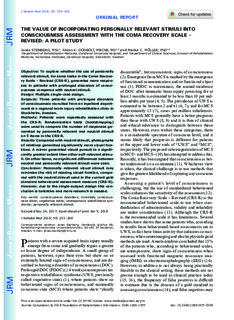| dc.contributor.author | Stenberg, Jonas | |
| dc.contributor.author | Godbolt, Alison Kate | |
| dc.contributor.author | Möller, Marika Christina | |
| dc.date.accessioned | 2018-08-13T11:19:18Z | |
| dc.date.available | 2018-08-13T11:19:18Z | |
| dc.date.created | 2018-01-12T08:38:14Z | |
| dc.date.issued | 2018 | |
| dc.identifier.issn | 1650-1977 | |
| dc.identifier.uri | http://hdl.handle.net/11250/2557739 | |
| dc.description.abstract | Objective: To explore whether the use of personally relevant stimuli, for some tasks in the Coma Recovery Scale – Revised (CRS-R), generates more responses in patients with prolonged disorders of consciousness compared with neutral stimuli.
Design: Multiple single-case design.
Subjects: Three patients with prolonged disorders of consciousness recruited from an inpatient department at a regional brain injury rehabilitation clinic in Stockholm, Sweden.
Methods: Patients were repeatedly assessed with the CRS-R. Randomization tests (bootstrapping) were used to compare the number of responses generated by personally relevant and neutral stimuli on 5 items in the CRS-R.
Results: Compared with neutral stimuli, photographs of relatives generated significantly more visual fixations. A mirror generated visual pursuit to a significantly greater extent than other self-relevant stimuli. On other items, no significant differences between neutral and personally relevant stimuli were seen.
Conclusion: Personally relevant visual stimuli may minimize the risk of missing visual fixation, compared with the neutral stimuli used in the current gold standard behavioural assessment measure (CRS-R). However, due to the single-subject design this conclusion is tentative and more research is needed. | nb_NO |
| dc.language.iso | eng | nb_NO |
| dc.publisher | Foundation for Rehabilitation Information | nb_NO |
| dc.rights | Navngivelse-Ikkekommersiell 4.0 Internasjonal | * |
| dc.rights.uri | http://creativecommons.org/licenses/by-nc/4.0/deed.no | * |
| dc.title | The value of incorporating personally relevant stimuli into consciousness assessment with the Coma Recovery Scale - Revised: A pilot study. | nb_NO |
| dc.type | Journal article | nb_NO |
| dc.type | Peer reviewed | nb_NO |
| dc.description.version | publishedVersion | nb_NO |
| dc.source.volume | 50 | nb_NO |
| dc.source.journal | Journal of Rehabilitation Medicine | nb_NO |
| dc.source.issue | 3 | nb_NO |
| dc.identifier.doi | 10.2340/16501977-2309 | |
| dc.identifier.cristin | 1541295 | |
| dc.description.localcode | This is an open access article under the CC BY-NC license. | nb_NO |
| cristin.unitcode | 194,65,30,0 | |
| cristin.unitname | Institutt for nevromedisin og bevegelsesvitenskap | |
| cristin.ispublished | true | |
| cristin.fulltext | original | |
| cristin.qualitycode | 1 | |

